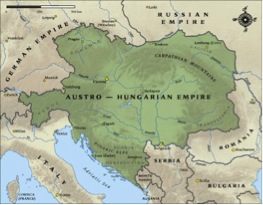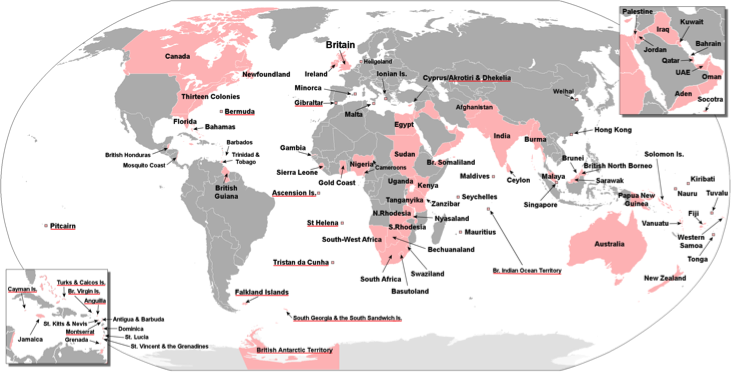Austro-Hungarian Empire: A union that formed between the Empire of Austria and the Kingdom of Hungary in 1867. In 1914 the Habsburg Monarchy ruled over Austro-Hungary, and the annexed provinces of Bosnia and Herzegovina. Archduke Franz Ferdinand, heir to the Habsburg throne, was assassinated on 28 June 1914 which contributed to the eventual outbreak of the First World War. When the war broke out the Austro-Hungarian Empire was the second largest country in Europe and was a member of the Triple Alliance. The empire dissolved in 1918 as a result of the war.

Visual: http://www.nzhistory.net.nz/media/photo/map-austro-hungarian-empire-1914
British Empire: At the outbreak of the First World War the British Empire consisted of numerous colonies and Dominions. When Britain declared war on 4 August 1914 the entire empire was automatically entered into the war. As a Dominion in the British Empire, Canada was drawn into the war on 4 August and expected to provide military, financial and material support to Great Britain. Below a map depicts the British Empire circa 1914.

Visual: http://upload.wikimedia.org/wikipedia/commons/2/26/The_British_Empire.png
Cadet: The Cadet Corps were originally created as a youth drill association for boys over the age of 12. The Corps were not part of the military but they did drill marksmanship and other forms of military training. Cadets were taught survival skills and leadership while working in a team environment. Cadets in Canada today include the Sea Cadets, Army Cadets and Air Cadets.
Canadian Red Cross Society: An organization founded in 1896, which was mandated to help the sick and wounded during times of war. Additionally, the organization collected donations and goods from Canadians during the Boer War and the First World War. Their involvement in medical services during the First World War was extensive.
Despotism: Form of government where a single entity, often referred to as a despot, rules with absolute power. A despot is often a king or other type of ruler who rules with complete authority.
Enemy (Aliens): An individual who originates from a country that is in conflict with the country they currently reside in.
Hague Treaty (1907): A treaty produced during the 1907 Hague Convention. The Hague Conventions of 1899 and 1907 resulted in a series of international treaties and declarations. In 1907, Treaty thirteen addressed the rights and duties of neutral powers during war. The treaty stated that belligerent countries were to respect the sovereign rights of neutral powers both on land and water. It was this treaty that Germany violated in August 1914.
Imperial Forces: Forces from the British Empire that fought in the First World War. Canada, Australia, New Zealand, South Africa, and India made significant contributions to the Imperial Forces.
Imperialism: Imperialism in Canada was rooted in their economic, military and political connections to Britain. Confederation in Canada occurred in 1867, gaining Canada the title of Dominion. As a Dominion Britain still controlled Canada’s external relations and defenses. Prior to the First World War imperialism in Canada meant development and progress beyond colonial status without separating from the empire. While Canadians were members of the British Empire, they began developing a national identity of their own, which was still deeply connected to imperialism.
Landwehr: The German term for Germany and Austria’s military forces.
Martial Law: The suspension of ordinary law during military operations, often preceded or accompanied by military mobilization.
Mobilization: The gathering of troops and supplies for war. The opposing party normally sees it as an act of aggression, if a state of war has not yet been declared.
Patriotism: The cultural attachment or devotion to one’s country, often displayed through the support and defense of one’s country. During the First World War there were two forms of patriotism in Canada. Canadians could display patriotism or loyalty to Canada as well as the British Empire. Canadians had a dual-identity that allowed them to demonstrate their devotion to Canada and Britain.
Propaganda: Biased information that is used to promote or publicize a political cause or viewpoint.
RMS Llandovery Castle: Was one of the five Canadian hospital ships to serve during the war. She was torpedoed and sunk on the 27th of June 1918. Her demise remains one of the most significant Canadian naval disasters of the First World War.
Servia: Modern day Serbia, a country located in the central Balkans. In 1914 Serbia was located directly south of Austria-Hungary and was to the east of Sarajevo, Bosnia where Archduke Franz Ferdinand and his wife were assassinated. Waterloo Region newspapers referred to Serbia as Servia; this spelling will be used in this website to stay consistent with the source material being used.
SS Laurentic: A steamship that operated from Liverpool to Canada. At the outbreak of the war, the ship was immediately placed in military service as a troop transport. She served until the 25th of January 1917 when she hit a mine.
Triple Alliance: A military alliance between Germany, Austria-Hungary and Italy formed in 1882. Its composition was in response to the growing strength of Russia and France. The members agreed to support each other in the event of war. If an act of aggression were made against any of the members, the treaty would ensure that the other two members could be brought into the conflict.
Triple Entente: A military alliance between the Russian Empire, the French Republic, and Great Britain. In 1894 Russia and France established a Franco-Russian Alliance, but later broke in 1900. France later signed the Entente cordiale with Britain in 1904. In 1907 Britain and Russia signed an agreement called the Anglo-Russian Convention of 1907, which allied the two powers; as a result, in 1907 the Triple Entente was formed between the three powers. This alliance was in response to the Triple Alliance, formed between Germany, Austria-Hungary, and Italy. The Triple Entente did not require each nation to automatically enter into war on behalf of one another, but instead stressed the member’s moral obligations to support one another.
Union Jack: The national flag of the United Kingdom, which is also referred to as the Union Flag. In 1914 the Union Jack was the official flag of Canada as well, and would be until 1965 when the Maple Leaf Flag replaced it. The Union Jack was flown across Canada as a sign of patriotism after war broke out in August 1914.
United Kingdom: Consisted of England, Scotland, Wales and Ireland in 1914, with England as the ruling body.
Valcartier: a military training camp erected in August 1914 for the mobilization for the Canadian Expeditionary Force after the outbreak of the First World War. Its name is derived from the municipality of Saint Gabriel de Valcartier, Quebec, where the camp is located. The camp is approximately 25 Km north of Quebec City. Valcartier now serves as a Canadian Forces Base (CFB).
War Measures Act: The Act was enacted in 22 August 1914. The act stated that war had existed since 4 August, and outlined the special powers the Governor-in-Council in Canada would take on during the war. This act gave the Canadian Government the means to deal with the war with authority and power. The Act addressed issues including censorship, powers to detain or deport enemy aliens, control over transport systems, trade restrictions, and an amendment to the Immigrations Act of 1910, among other things. To read the full act see: http://eco.canadiana.ca/view/oocihm.9_08039/2?r=0&s=1
Waterloo Region: Although this is the current term for the region, in 1914 the region was referred to as Waterloo County. For the purpose of this study we have used the current boundaries of Waterloo Region. Currently Waterloo Region includes three urban municipalities, Kitchener (formerly Berlin), Waterloo, and Cambridge (formerly Galt, Hespeler and Preston) and four rural townships, North Dumfries, Wilmot, Woolwich and Wellesley. A map of the region can be seen on the home page of the website.


